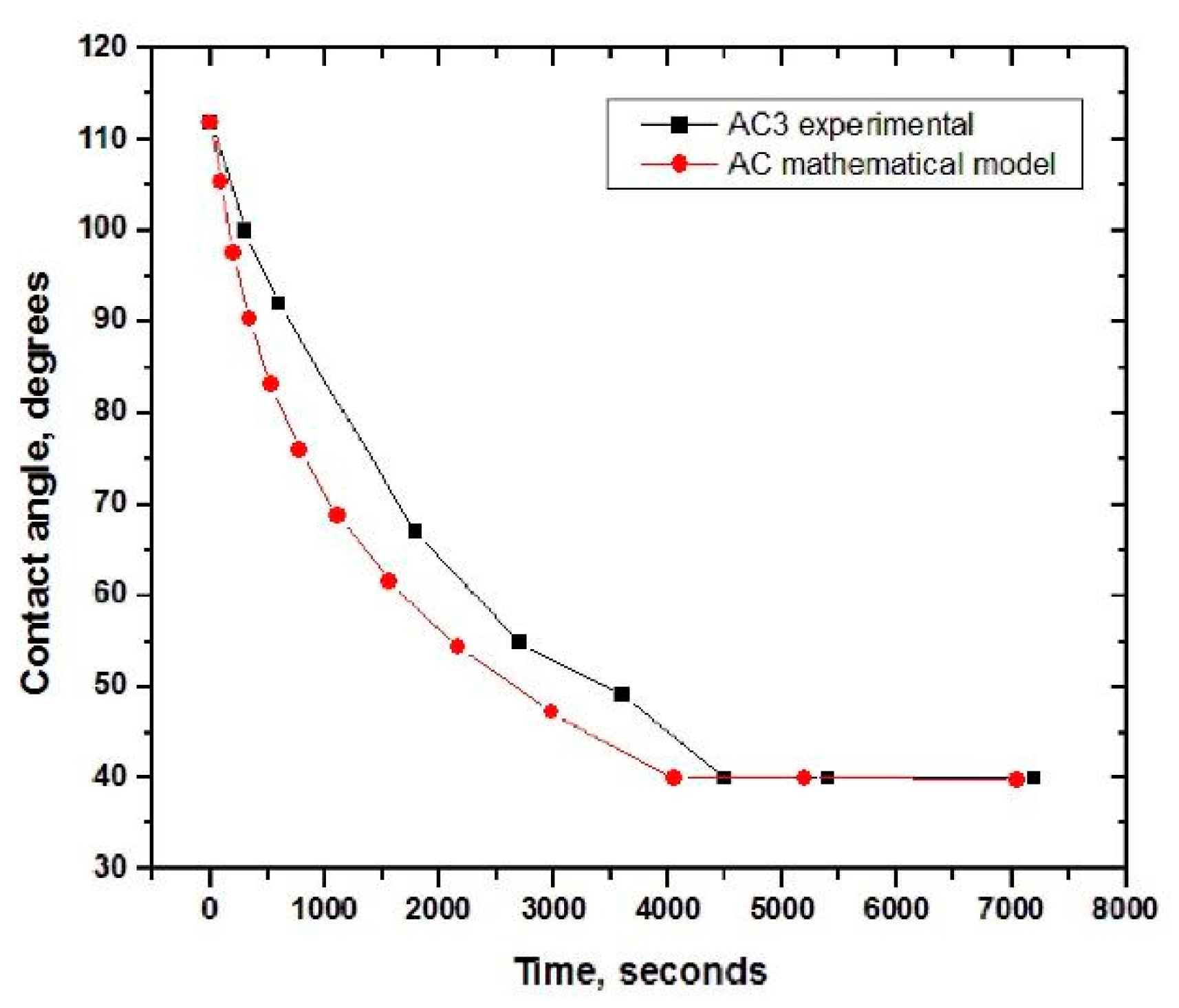Mathematical Simulation of the Wettability of Al2O3 Substrate through Different Aluminum Alloys
Abstract
1. Introduction
2. Description of the Mathematical Model
- r = is the radius of the atoms of the liquid
- γ1 = liquid surface tension
- θe = contact angle in equilibrium
- θ = non-equilibrium contact angle
- Vo = Vibrational frequency of the atoms
- Q = Activation energy of diffusion
- K = Boltzmann’s constant
- T = Absolute temperature
- Q = Activation energy
- K = Boltzmann’s constant
- T = Absolute temperature
- γ1 = Surface tension of the droplet
- θe = Equilibrium angle of wetting
- R = Drop radius
- Do = Frequency factor
- r = Radius of the atom
3. Materials and Methods
3.1. Substrate Preparation
3.2. Wettability Experiments
4. Results
4.1. Contact Angle Variation
4.2. Metal–Ceramic Interface
4.3. Mathematical Simulation
5. Conclusions
Author Contributions
Funding
Conflicts of Interest
References
- Eustathopoulos, N. Wetting by liquid metals—Application in materials processing: The contribution of the grenoble group. Metals 2015, 5, 350–370. [Google Scholar] [CrossRef]
- Marmur, A. Solid-surface characterization by wetting. Annu. Rev. Mater. Sci. 2009, 39, 473–489. [Google Scholar] [CrossRef]
- Levi, G.; Kaplan, W.D. Iron as an oxygen tracer at the aluminum-alumina interface. J. Am. Ceram. Soc. 2002, 85, 1601–1606. [Google Scholar] [CrossRef]
- Shen, P.; Fujii, H.; Matsumoto, T.; Nogi, K. Critical factors affecting the wettability of α-alumina by molten aluminum. J. Am. Ceram. Soc. 2005, 87, 2151–2159. [Google Scholar] [CrossRef]
- Nicholas, M.G. Ceramic-metal interfaces. In Surfaces and Interfaces Ceramics Materials, 1st ed.; Dufour, L.C., Monty, C., Eds.; Springer: Heidelberg, The Netherlands, 1989; pp. 393–417. [Google Scholar]
- Bao, S.; Tang, K.; Kvithyld, A.; Tangstad, M.; Engh, T.A. Wettability of Aluminum on Alumina. Metall. Mater. Trans. A 2011, 42, 1358–1366. [Google Scholar] [CrossRef]
- Duta, L.; Popescu, A.; Zgura, I.; Preda, N.; Mihailescu, N.P.A.I. Wettability of nanostructured surfaces. In Wetting and Wettability; IntechOpen: London, UK, 2015; pp. 207–252. [Google Scholar]
- Zhou, X.B.; De Hosson, J.T.M. Wetting kinetics of liquid aluminium on an Al2O3 surface. J. Mater. Sci. 1995, 30, 3571–3575. [Google Scholar] [CrossRef]
- Okamoto, H. Al-La (aluminum-lanthanum). J. Phase Equilibria Diffus. 2007, 28, 581. [Google Scholar] [CrossRef]
- Liu, S.; Du, Y.; Xu, H.; He, C.; Schuster, J.C. Experimental investigation of the Al–Y phase diagram. J. Alloy. Compd. 2006, 414, 60–65. [Google Scholar] [CrossRef]
- Khanna, S. Oxidation of pure metals. In Handbook of Environmental Degradation of Materials, 3rd ed.; Kutz, M., Ed.; Elsevier: Norwich, NY, USA, 2018. [Google Scholar]
- Kingery, W.D. Distribution and influence of minor constituents on ceramic formulations. In Ceramic Microstructures ’86; Springer Science and Business Media LLC: Berlin, Germany, 1987; pp. 281–294. [Google Scholar]
- Landry, K.; Kalogeropoulou, S.; Eustathopoulos, N.; Naidich, Y.; Krasovsky, V. Characteristic contact angles in the alumi-num/vitreous carbon system. Scr. Mater. 1996, 34, 841–846. [Google Scholar] [CrossRef]
- Rocha-Rangel, E.; Becher, P.F.; Lara-Curzio, E. Influence of carbon on the interfacial contact angle between alumina and liquid aluminum. Surf. Interface Anal. 2003, 35, 151–155. [Google Scholar] [CrossRef]
- Feng, X.; Jiang, L. Design and creation of superwetting/antiwetting surfaces. Adv. Mater. 2006, 18, 3063–3078. [Google Scholar] [CrossRef]
- Bao, S.; Kvithyld, A.; Engh, T.A.; Tangstad, M. Wettability of aluminium with SIC and graphite in aluminium filtration. In Light Metals, 1st ed.; Stephen, J.L., Ed.; Springer Cham: New York, NY, USA, 2011; pp. 775–782. [Google Scholar]
- Watanabe, T. Wettability of ceramic surfaces—A wide range control of surface wettability from super hydrophilicity to super hydrophobicity, from static wettability to dynamic wettability. J. Ceram. Soc. Jpn. 2009, 117, 1285–1292. [Google Scholar] [CrossRef]
- Kubiak, K.; Wilson, M.; Mathia, T.; Carval, P. Wettability versus roughness of engineering surfaces. Wear 2011, 271, 523–528. [Google Scholar] [CrossRef]
- Kingery, W.D.; Bowen, H.K.; Uhlmann, D.R. Introduction to Ceramics; Wiley: New York, NY, USA, 1960. [Google Scholar]
- Brennan, J.J.; Pask, J.A. Effect of nature of surfaces on wetting of sapphire by liquid aluminum. J. Am. Ceram. Soc. 1968, 51, 569–573. [Google Scholar] [CrossRef]
- Landry, K.; Eustathopoulos, N. Dynamics of wetting in reactive metal/ceramic systems: Linear spreadin. Acta Mater. 1996, 44, 3923–3932. [Google Scholar] [CrossRef]







| Sample | System | Carbon-Coated Substrate |
|---|---|---|
| A1 | Al-Al2O3 | Control |
| AC1 | Al-Al2O3 | 1 cycle C deposition |
| AC3 | Al-Al2O3 | 3 cycles C deposition |
| AY | Al-3% Y-Al2O3 | No |
| AL | Al-2.5 La-Al2O3 | No |
| ACY | Al-3% Y-Al2O3 | 3 cycles C deposition |
| ACL | Al-2.5 La-Al2O3 | 3 cycles C deposition |
Publisher’s Note: MDPI stays neutral with regard to jurisdictional claims in published maps and institutional affiliations. |
© 2021 by the authors. Licensee MDPI, Basel, Switzerland. This article is an open access article distributed under the terms and conditions of the Creative Commons Attribution (CC BY) license (https://creativecommons.org/licenses/by/4.0/).
Share and Cite
Rocha-Rangel, E.; Rodríguez-García, J.A.; Castillo-Robles, J.A.; Mireles, E.N.A.; Calles-Arriaga, C.A. Mathematical Simulation of the Wettability of Al2O3 Substrate through Different Aluminum Alloys. J. Compos. Sci. 2021, 5, 161. https://doi.org/10.3390/jcs5060161
Rocha-Rangel E, Rodríguez-García JA, Castillo-Robles JA, Mireles ENA, Calles-Arriaga CA. Mathematical Simulation of the Wettability of Al2O3 Substrate through Different Aluminum Alloys. Journal of Composites Science. 2021; 5(6):161. https://doi.org/10.3390/jcs5060161
Chicago/Turabian StyleRocha-Rangel, Enrique, José A. Rodríguez-García, José A. Castillo-Robles, Eddie N. Armendáriz Mireles, and Carlos A. Calles-Arriaga. 2021. "Mathematical Simulation of the Wettability of Al2O3 Substrate through Different Aluminum Alloys" Journal of Composites Science 5, no. 6: 161. https://doi.org/10.3390/jcs5060161
APA StyleRocha-Rangel, E., Rodríguez-García, J. A., Castillo-Robles, J. A., Mireles, E. N. A., & Calles-Arriaga, C. A. (2021). Mathematical Simulation of the Wettability of Al2O3 Substrate through Different Aluminum Alloys. Journal of Composites Science, 5(6), 161. https://doi.org/10.3390/jcs5060161







